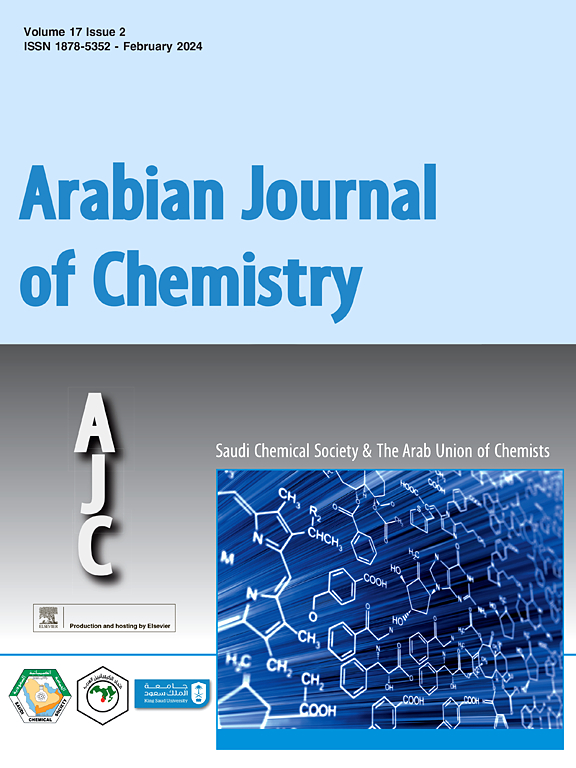黄腐素与蛋白质的相互作用、分子对接以及在人类慢性髓性白血病 K562 细胞中的抗肿瘤活性
IF 5.2
2区 化学
Q2 CHEMISTRY, MULTIDISCIPLINARY
引用次数: 0
摘要
黄腐素(C15H14O4)是一种天然的线性吡喃香豆素,具有抗癌活性,但其抗癌机制尚不清楚。人类血红蛋白(HHb)作为一种主要的血浆蛋白,可能在治疗分子的运输和生物分布中发挥关键作用。本研究利用多光谱技术和分子对接模拟,测量了黄腐酸与HHb在生理条件下的相互作用。此外,还通过细胞试验评估了黄腐酸与人类慢性髓性白血病 K562 细胞的相互作用。结果表明,每个黄腐素分子都与一分子 HHb 发生了热力学上有利的相互作用,其结合常数(Kb)在 103-4 M-1 数量级。这些相互作用不会明显导致 HHb α-螺旋成分的损失。硅学研究支持了实验结果,并证明包括氢键(Ala88和Arg92)、π-π堆叠(Trp37)和疏水相互作用(Pro95和Pro36)在内的非共价作用力是黄独素-HHb复合物形成的主要原因。细胞和分子测定显示,黄腐素通过过表达 p53、caspase-3 和 PARP 分裂诱导细胞凋亡,从而减缓了 K562 细胞的增殖。这些数据为开发具有潜在血液蛋白结合能力的黄腐素衍生物/杂交化合物带来了巨大希望。本文章由计算机程序翻译,如有差异,请以英文原文为准。
Interaction of xanthoxyletin with protein, molecular docking and antitumor activity in human chronic myeloid leukemia K562 cells
Xanthoxyletin (C15H14O4), a natural linear pyranocoumarin, is known to trigger anti-cancer activities, although its anticancer mechanisms are largely unknown. Human hemoglobin (HHb) as a major plasma protein could play a key role in the transportation and biodistribution of therapeutic molecules In this study, the interaction of xanthoxyletin with HHb was measured under physiological conditions using multi-spectroscopic techniques along with molecular docking simulation. Also, the interaction of xanthoxyletin with human chronic myeloid leukemia K562 cells was assessed by cellular assays. It was deduced that each xanthoxyletin molecule shows a thermodynamically favorable interaction with one molecule of HHb with a binding constant (Kb) in the orders of 103-4 M−1. These interactions did not significantly result in the loss of α-helical content of HHb. In silico studies supported the experimental findings and demonstrated that non-covalent forces including hydrogen bonds (Ala88 and Arg92), pi-pi stacking (Trp37), and hydrophobic interactions (and Pro95 and Pro36) are the main forces contributing to the xanthoxyletin-HHb complex formation. Cellular and molecular assays showed that xanthoxyletin mitigated the proliferation of K562 cells through apoptosis induction mediated by overexpression of p53, caspase-3, and PARP cleavage. This data may hold great promise for the development of anticancer compounds with potential blood protein binding stemming from xanthoxyletin derivatives/hybrids.
求助全文
通过发布文献求助,成功后即可免费获取论文全文。
去求助
来源期刊

Arabian Journal of Chemistry
CHEMISTRY, MULTIDISCIPLINARY-
CiteScore
10.80
自引率
3.30%
发文量
763
审稿时长
63 days
期刊介绍:
The Arabian Journal of Chemistry is an English language, peer-reviewed scholarly publication in the area of chemistry. The Arabian Journal of Chemistry publishes original papers, reviews and short reports on, but not limited to: inorganic, physical, organic, analytical and biochemistry.
The Arabian Journal of Chemistry is issued by the Arab Union of Chemists and is published by King Saud University together with the Saudi Chemical Society in collaboration with Elsevier and is edited by an international group of eminent researchers.
 求助内容:
求助内容: 应助结果提醒方式:
应助结果提醒方式:


